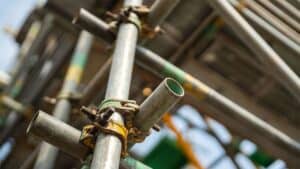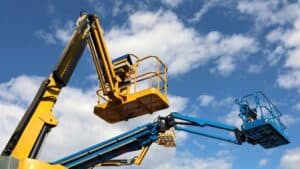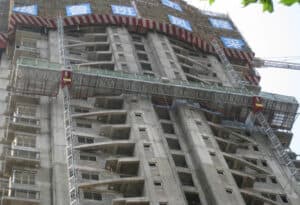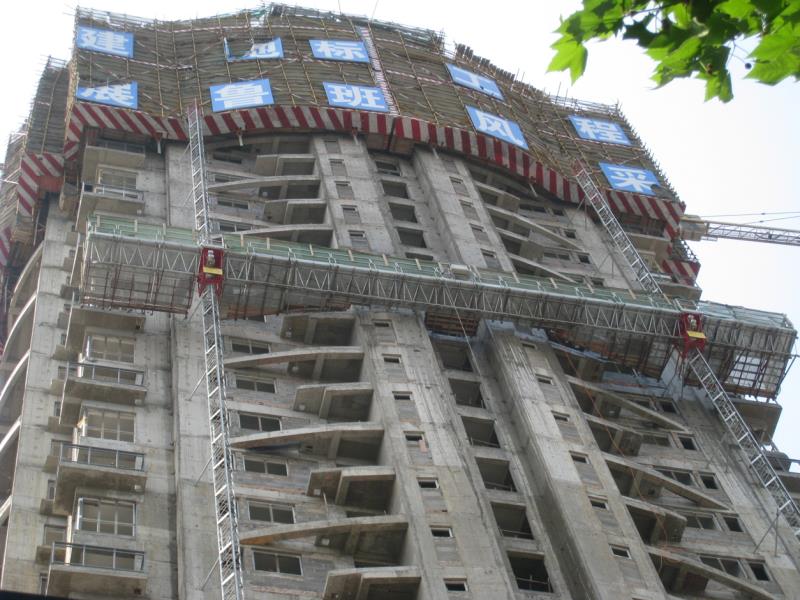
In the evolving construction industry, the debate between traditional scaffolding and innovative mast climbers hinges on efficiency, cost, and adaptability. While scaffold systems have long dominated construction sites, mast climber offers cost savings, safety and efficiency for the construction project.
Unlike scaffolding setups that require extensive labour to assemble and dismantle, mast climbers deploy a dynamic work platform that adjusts vertically in minutes, minimising downtime and accelerating project timelines.
In this article, we will explain the main differences between mast climber and scaffolding. Help you to choose the product that is more suitable for your building project.
Definition and Usage of Mast Climbers
A mast climber is a vertical platform that moves up and down a tower-like mast. It’s used for various building tasks including new construction, repairs and maintenance.
The platform rises and lowers with the push of a button, allowing workers and materials to reach precise heights.
Mast climbers are known for their quick installation which saves the labor costs and reduces project timelines.
Generally, mast climbers are safer than traditional options, cause they provide stable working surfaces and reduce the risk of falls and can be positioned at the exact working height needed, which means less climbing and bending for workers.
Definition and Usage of Scaffolding
Scaffolding has been used in construction for centuries.
Scaffolding consists of temporary elevated platforms supported by a frame structure. It’s made of metal tubes or pipes connected with couplers and boards.
Traditional scaffolding is versatile and can be adapted to fit almost any building shape which allows workers to access different areas of a structure’s exterior. Furthermore, the modular design means it can be assembled in various configurations.
However, the setup time for scaffolding is longe. This extended installation period adds to labor costs and can delay project start times, and it’s associated with more safety incidents than mast climbers.
Workers must climb between levels, which increases fall risks and physical strain.
Safety Considerations
Safety is somehow the most important factor when choosing between mast climbers and scaffolding.
Safety Features in Mast Climbers
Mast climbers come with several built-in safety features that make them a safer option in many situations. They include overload sensors that prevent the platform from moving when carrying too much weight.
Most modern mast climbers have emergency descent systems that allow workers to safely lower the platform if power fails and the enclosed platform design reduces the risk of falls which is a common hazard in construction.
Safety Protocols for Scaffolding
Proper assembly is the foundation of scaffolding safety. All components must be inspected for damage before use, and the structure needs to be built on stable, level ground. Guardrails must be installed at appropriate heights.
For preventing tipping and collapse, ensure the scaffolding is secured to the building at regular intervals.
Fall protection equipment like harnesses is be required when working on scaffolding which provides an additional layer of safety beyond the structural protections.
Loading limits must be strictly observed with scaffolding. Overloading platforms is a common cause of scaffold failures and serious accidents.
Cost Analysis
Initial Investment for Mast Climbers
Mast climbers require a higher upfront investment compared to traditional scaffolding.
A single mast climbing unit can cost between $60,000 to $150,000 depending on the height capability and load capacity.
However, the mast climbers can be installed in just three days, compared to scaffolding which might take up to twenty-five days. This quick setup reduces labor costs dramatically.
If you still think the initial investment is too high, you can consider Ihurmo’s mast climbing lift which designed for both efficiency and cost-effectiveness.
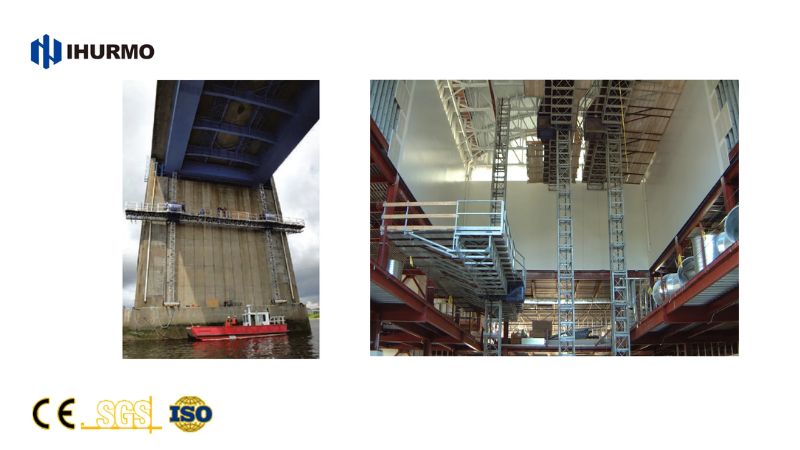
IHURMO Twin-mast Mast Climber Scaffold has modular structure which allows rapid assembly and disassembly, adapting to complex building geometries while maintaining stability even at extreme heights. With a load capacity optimized for heavy-duty materials and workers, it ensures seamless operations without compromising safety.
It also minimizes energy consumption while delivering smooth, precise vertical movement—ideal for prolonged operations in high-rise environments.
Starting at just $20,000 (upto $40,000 based on configuration), Ihurmo’s Mast Climbing Lift delivers premium vertical access at one-third the market price—all while tailoring the system to your project’s exact needs, from platform size to load capacity. Contact us to get more information.
Scaffolding Setup and Costs
Scaffolding generally has a lower entry cost which makes it initially attractive for smaller projects or companies with limited capital.
However, the hidden costs emerge during implementation. Setup labor is intensive, requiring large crews working for extended periods. A medium-sized building may need 3-4 weeks of assembly time with a team of workers.
Material loss is another expense factor. 15-20% of scaffolding materials may be damaged or lost during each project cycle, adding replacement costs to your budget.
Efficiency and Accessibility
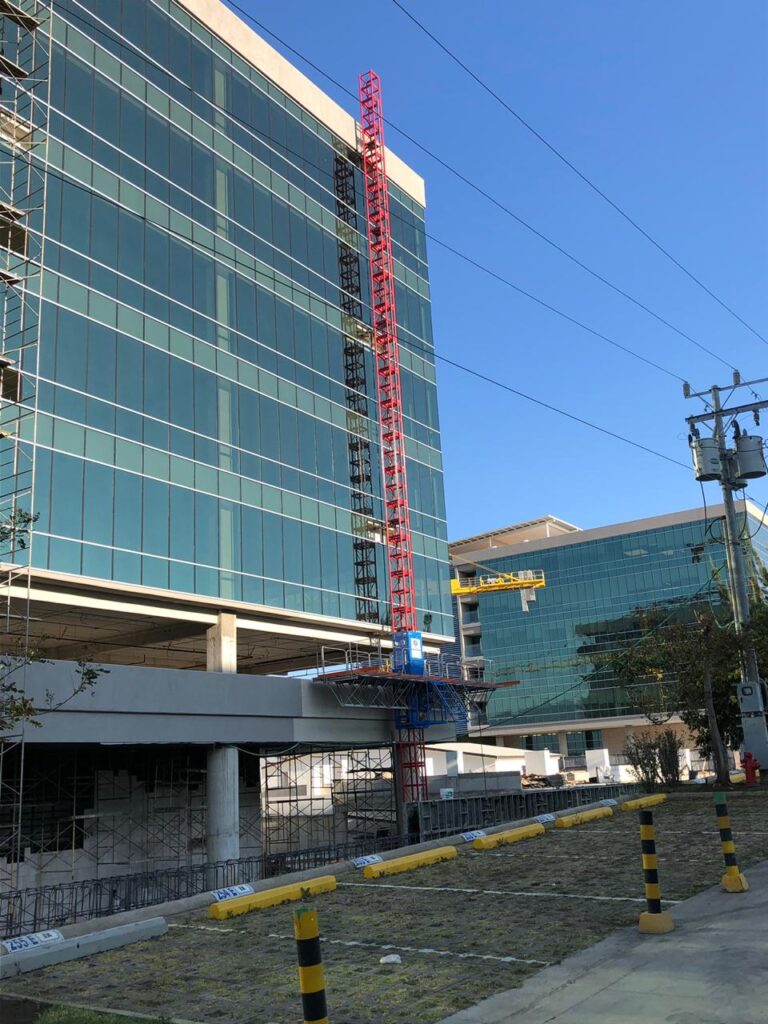
Work Efficiency with Mast Climbers
Workers appreciate the higher load-bearing capacity of mast climbers. They can carry much heavier loads than traditional scaffolding, allowing them to keep more materials at the work area. This will reduces time spent retrieving supplies from ground level.
The platforms can be positioned at exact working heights, eliminating the need for workers to bend, stretch, or work in uncomfortable positions.
This positioning capability translates to:
- Fewer breaks needed due to physical strain
- Higher quality workmanship
- Faster completion of tasks
Setup and Dismantling Time
Mast Climber Installation Timeline
Mast climbers offer impressively fast setup. It can be settle down quickly, depending on the height and complexity of your project.
The process begins with setting the base and installing the mast sections. Then workers attach the platform components and complete safety checks. What makes mast climbers efficient is their vertical extension capability without needing to dismantle and rebuild.
For dismantling, the process is equally efficient. Workers can typically take down a mast climber in about half the time required for setup, often completing the task in less than a day.
Timeframe for Scaffolding Setup and Removal
Traditional scaffolding requires significantly more time to erect s. The process involves assembling frame by frame, level by level, with multiple connection points.
Your scaffolding installation timeline includes:
- Ground preparation
- Frame and brace assembly
- Platform installation
- Guardrail attachment
- Safety net installation
The dismantling process for scaffolding is equally time-consuming. You must carefully disassemble each component in the reverse order of installation. This typically takes 2-3 days for a project of average complexity.
Frequently Asked Questions
What safety guidelines should be followed when operating a mast climber scaffold?
Always ensure proper training for all personnel who will use or work near mast climbers.
Never exceed the manufacturer’s specified weight capacity. Most accidents occur when supports give way due to overloading or when workers slip on platforms.
Use appropriate fall protection equipment even though mast climbers have guardrails. Keep platforms clear of debris and tools to prevent trip hazards and items falling onto workers below.
Could you explain the different types of scaffolding and how they are used in construction?
Supported scaffolding stands on the ground and includes frame scaffolds (the most common type), tube and coupler scaffolds (highly adaptable), and system scaffolds (pre-engineered components).
Suspended scaffolding hangs from the top of buildings and is ideal for work on high-rise exteriors. These include single-point, multi-point, and interior hung systems.
Specialty scaffolds include mast climbers, which combine features of both supported and powered systems. Rolling scaffolds allow mobility on flat surfaces, while pump jack scaffolds are lightweight systems for residential work.
What should be understood about the impact of mast climbers and scaffolding on work efficiency and productivity in construction?
Mast climbers can significantly increase productivity by reducing the time workers spend climbing up and down.
Material handling becomes more efficient with mast climbers, as they can be loaded with larger quantities of materials. This reduces the number of required lifts and minimizes worker fatigue.


